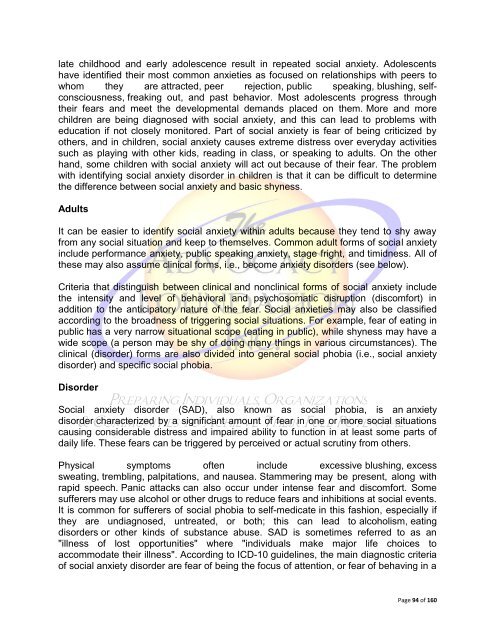The Gift of Introversion
The Gift of Introversion
The Gift of Introversion
Create successful ePaper yourself
Turn your PDF publications into a flip-book with our unique Google optimized e-Paper software.
late childhood and early adolescence result in repeated social anxiety. Adolescents<br />
have identified their most common anxieties as focused on relationships with peers to<br />
whom they are attracted, peer rejection, public speaking, blushing, selfconsciousness,<br />
freaking out, and past behavior. Most adolescents progress through<br />
their fears and meet the developmental demands placed on them. More and more<br />
children are being diagnosed with social anxiety, and this can lead to problems with<br />
education if not closely monitored. Part <strong>of</strong> social anxiety is fear <strong>of</strong> being criticized by<br />
others, and in children, social anxiety causes extreme distress over everyday activities<br />
such as playing with other kids, reading in class, or speaking to adults. On the other<br />
hand, some children with social anxiety will act out because <strong>of</strong> their fear. <strong>The</strong> problem<br />
with identifying social anxiety disorder in children is that it can be difficult to determine<br />
the difference between social anxiety and basic shyness.<br />
Adults<br />
It can be easier to identify social anxiety within adults because they tend to shy away<br />
from any social situation and keep to themselves. Common adult forms <strong>of</strong> social anxiety<br />
include performance anxiety, public speaking anxiety, stage fright, and timidness. All <strong>of</strong><br />
these may also assume clinical forms, i.e., become anxiety disorders (see below).<br />
Criteria that distinguish between clinical and nonclinical forms <strong>of</strong> social anxiety include<br />
the intensity and level <strong>of</strong> behavioral and psychosomatic disruption (discomfort) in<br />
addition to the anticipatory nature <strong>of</strong> the fear. Social anxieties may also be classified<br />
according to the broadness <strong>of</strong> triggering social situations. For example, fear <strong>of</strong> eating in<br />
public has a very narrow situational scope (eating in public), while shyness may have a<br />
wide scope (a person may be shy <strong>of</strong> doing many things in various circumstances). <strong>The</strong><br />
clinical (disorder) forms are also divided into general social phobia (i.e., social anxiety<br />
disorder) and specific social phobia.<br />
Disorder<br />
Social anxiety disorder (SAD), also known as social phobia, is an anxiety<br />
disorder characterized by a significant amount <strong>of</strong> fear in one or more social situations<br />
causing considerable distress and impaired ability to function in at least some parts <strong>of</strong><br />
daily life. <strong>The</strong>se fears can be triggered by perceived or actual scrutiny from others.<br />
Physical symptoms <strong>of</strong>ten include excessive blushing, excess<br />
sweating, trembling, palpitations, and nausea. Stammering may be present, along with<br />
rapid speech. Panic attacks can also occur under intense fear and discomfort. Some<br />
sufferers may use alcohol or other drugs to reduce fears and inhibitions at social events.<br />
It is common for sufferers <strong>of</strong> social phobia to self-medicate in this fashion, especially if<br />
they are undiagnosed, untreated, or both; this can lead to alcoholism, eating<br />
disorders or other kinds <strong>of</strong> substance abuse. SAD is sometimes referred to as an<br />
"illness <strong>of</strong> lost opportunities" where "individuals make major life choices to<br />
accommodate their illness". According to ICD-10 guidelines, the main diagnostic criteria<br />
<strong>of</strong> social anxiety disorder are fear <strong>of</strong> being the focus <strong>of</strong> attention, or fear <strong>of</strong> behaving in a<br />
Page 94 <strong>of</strong> 160

















